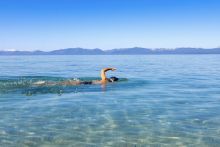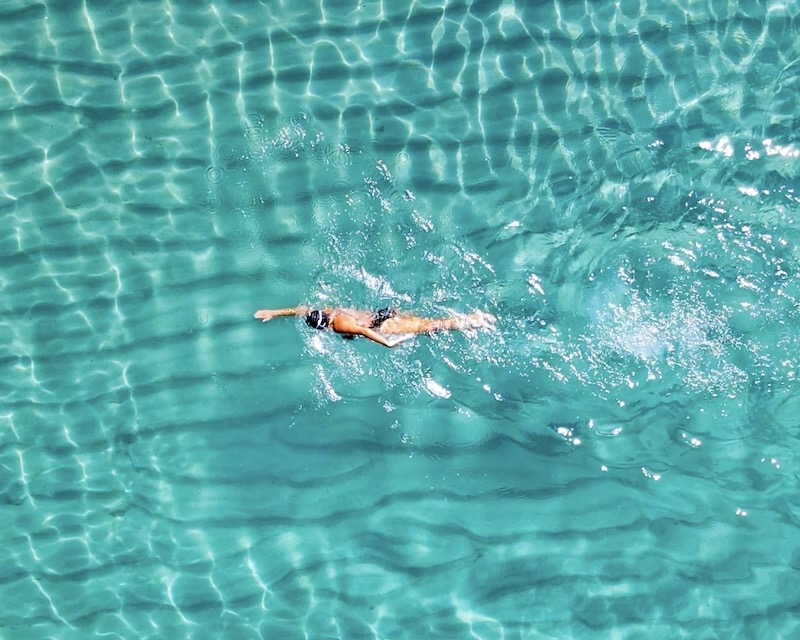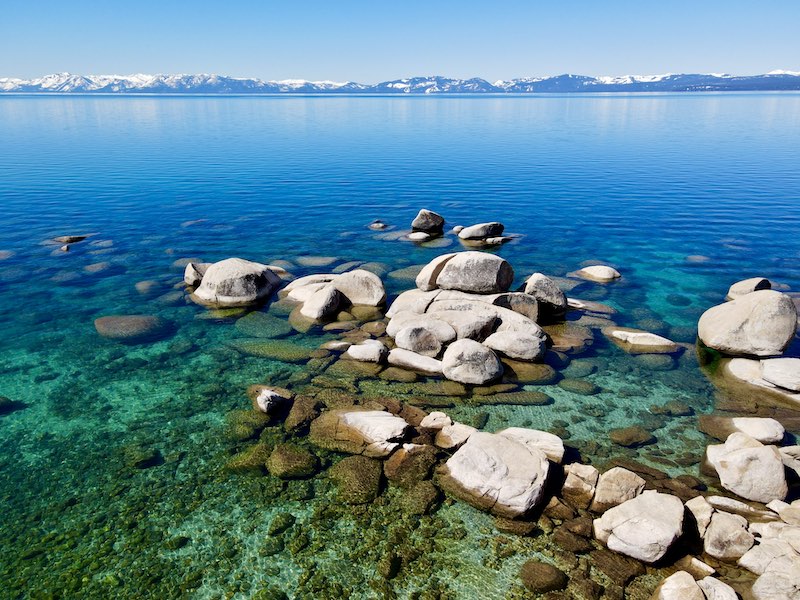
Cold plunges are all the rage in the wellness industry these days. From at-home ice baths to swimming sessions in frigid alpine lakes, people have been taking the plunge to take advantage of the multitude of benefits. But does it live up to the hype?
Research says it does! And I can tell you from my own personal experience that it has added excitement to my morning routine, enhanced my mood with a natural boost of energy, helped to reduce inflammation and optimized my sleep schedule.
Here in Lake Tahoe, we have access to a free cold plunge year-round, and arguably one of the most scenic plunge locations in the world! With 72 miles of shoreline, there are plenty of beaches to try the plunge or go for a swim. Some of the ones I recommend with easy access are Hidden Beach, Sand Harbor, Cave Rock, Patton Beach, Zephyr Cove, Baldwin Beach and Meeks Bay.
I will also recommend starting slowly and in a shallow area to ensure proper acclimation and awareness of your tolerance. Be sure to check in with yourself to see how you feel, and take breaks. Start with a goal of 30 seconds, and then work your way up as it feels right. Remember, challenging yourself is great, but safety is always the priority!
Below, I have outlined five benefits of taking the plunge. Who knows, you just might add it to your daily routine!

Cold-water immersion and swimming is a great way to kickstart the day! Photo by Christian Francisco.
1. Improves Mood and Focus
Cold-water immersion is a great way to revitalize your mind and body. Alongside the initial shock and burst of adrenaline from the chilly temperature, your body produces feel-good hormones known as dopamine.
We live in a world where we are surrounded by constant stimulation and stress. It’s important to not only take time to relax and reboot, but also to find ways to recharge. This is where cold-water therapy comes in.
According to the Stanford Center on Longevity, this release of hormones and neurotransmitters from taking the plunge can result in immediate and long-term benefits for your mental well-being. Many people, from participants in studies to wellness enthusiasts, have reported an increase in motivation, focus and overall mood. As well, reports of decreased stress, depressive thoughts and fatigue have emerged. The Stanford Center on Longevity goes on to report that just adding a 5-minute swim or immersion to your routine can help stabilize and increase your mood, focus and sleep regulation.
The regulation of sleep is a great bonus, as that contributes to lower levels of stress, improved balance, increased energy for the day and strong muscle and mindset recovery.
2. Helps Reduce Inflammation
If you’re anything like me and are recovering from an injury, you will enjoy this benefit!
In my search for the optimal recovery routine, I found the most effective way to combat inflammation and soreness to be a combination of hot and cold therapies, placing an emphasis on cold treatments. I have tried everything from ice machines to cryotherapy and found that cold water immersion was not only the most effective for my injury site, but also my overall recovery from training sessions and everyday mental stressors.
According to the UCLA Health Department, cold water therapy can be crucial to the healing process, as it makes your blood vessels constrict. This triggers a response that sends blood to your organs. Once you are out of the water and your body warms back up to its normal temperature, your blood vessels carry blood back to your soft tissues, which helps decrease inflammation.
This also helps to increase circulation throughout your body, which improves your cardiovascular health, metabolism and immune system.
The more you practice cold water immersion, the more benefits you will see and feel!

3. Boosts Immune System
Cold-water exposure is a great way to boost the immune system, which builds up mental and physical resilience. However, it is shown that the results are seen over time and not just with sporadic exposure. As well, it is advised to be mindful of the amount of exposure to avoid hypothermia.
Regular, and regulated, exposure, according to a Study in the National Library of Medicine, helps to activate and influence the central nervous system, lower inflammation and lessen the effects and onset of flu-like symptoms.
Thus, repeated cold water exposure, along with regulated breathwork and healthy fitness and nutritional habits, can help to strengthen the system and build up resilience to diseases. This can also help to lessen the duration of disease, such as colds or flus. Although the studies are relatively new and data is still emerging, the hypothesis is clear that we do have power to influence how our body responds to outside stimuli over time.
4. Helps Regulate Sleep
According to Vail Health, cold-water immersion can trigger a response similar to the drop in temperature that happens before you go to sleep. This is especially helpful for people who deal with insomnia or sleep issues, as it can help re-invigorate your circadian rhythm and sleep routine.
5. Adds a Fun Element to Your Routine
Taking the plunge adds an exciting, and adrenaline-inducing, element to your routine. Not only does it help to boost your energy to give you motivation for the day, but it also adds fun challenges (as long as it's done in a safe and controlled manner). Having challenges and goals is a great way to stay driven, and that also applies to work, hobbies and personal life. If challenges and changes are seen as "fun" instead of a chore, the body and mind respond in a more positive manner.
Don't have time for the lake? You can take a cold shower instead. Keeping your routine consistent, and building upon new habits, is a great way to stay away from stagnation and unhealthy habits.
The most important thing is to do this safely. Always listen to your body and work up to longer intervals. And, of course, have fun!
Tips:
-
Start out slowly to get your mind and body used to the temperature and process. If you can, try to start in a shallow area. This way, you can ease into it safely.
-
Focus on your body and your breath. Be mindful of how you are responding.
-
Make sure to stay hydrated, as dehydration can affect your body's response to the dramatic change of temperature.
-
Challenge yourself in each session, but keep safety as the top priority. Get out of the water if you start to feel lightheaded, numb or have difficulty breathing.
-
Have someone go with you, and if you do go solo make sure you aren’t alone at the beach.


 Kirsten is an outdoor adventure enthusiast, writer and photographer. You can typically find her hiking, paddleboarding, cross-country skiing and checking out new spots to share in the Tahoe Donner region. She has been lucky to call Tahoe her second home since she was a child and aims to inspire people to experience Tahoe and fall in love with the beauty and adventurous spirit of the region through her blogs and content.
Kirsten is an outdoor adventure enthusiast, writer and photographer. You can typically find her hiking, paddleboarding, cross-country skiing and checking out new spots to share in the Tahoe Donner region. She has been lucky to call Tahoe her second home since she was a child and aims to inspire people to experience Tahoe and fall in love with the beauty and adventurous spirit of the region through her blogs and content. 






